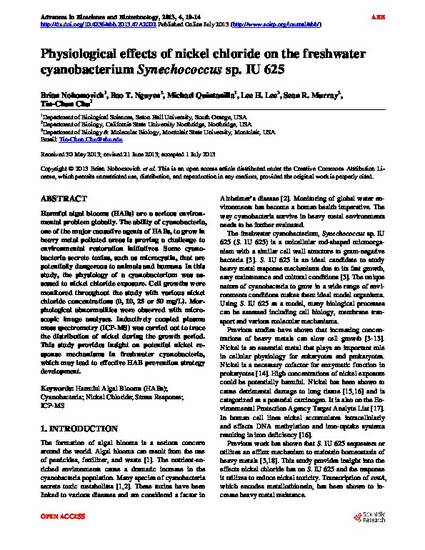
Article
Physiological effects of nickel chloride on the freshwater cyanobacterium Synechococcus sp. IU 625
Advances in Bioscience and Biotechnology
(2013)
Abstract
Harmful algal blooms (HABs) are a serious environmental problem globally. The ability of cyanobacteria, one of the major causative agents of HABs, to grow in heavy metal polluted areas is proving a challenge to environmental restoration initiatives. Some cyanobacteria secrete toxins, such as microcystin, that are potentially dangerous to animals and humans. In this study, the physiology of a cyanobacterium was assessed to nickel chloride exposure. Cell growths were monitored throughout the study with various nickel chloride concentrations (0, 10, 25 or 50 mg/L). Morphological abnormalities were observed with microscopic image analyses. Inductively coupled plasma mass spectrometry (ICP-MS) was carried out to trace the distribution of nickel during the growth period. This study provides insight on potential nickel response mechanisms in freshwater cyanobacteria, which may lead to effective HAB prevention strategy development.
Keywords
- Harmful Algal Blooms (HABs); Cyanobacteria; Nickel Chloride; Stress Response; ICP-MS
Disciplines
Publication Date
Summer July 4, 2013
Citation Information
Brian Nohomovich, Bao T. Nguyen, Michael Quintanilla, Lee H. Lee, et al.. "Physiological effects of nickel chloride on the freshwater cyanobacterium Synechococcus sp. IU 625" Advances in Bioscience and Biotechnology Vol. 4 Iss. 7B (2013) Available at: http://works.bepress.com/tin-chun_chu/19/
